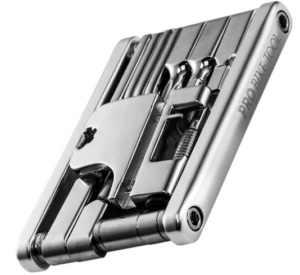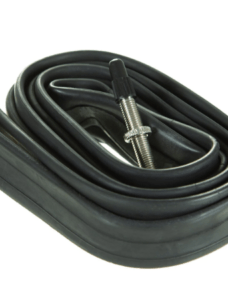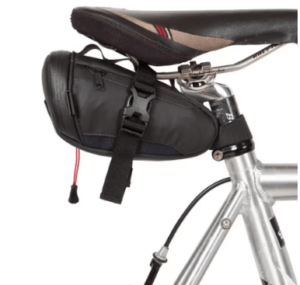Von Collins is an accomplished triathlete and endurance cyclist, and the author of four fitness and training books: Smarter Running, Your First Triathlon Guide, Fit Foods, and 30 Rut-Busting Workouts. He has been cited as a triathlon, cycling, and fitness expert by Healthline, CNET, Forbes, Eat This, Not That and other major outlets.
What to Keep in Your Bike Bag: Essential Items for Every Cyclist
Bike bags are perhaps one of the underrated pieces of equipment for cyclist, whether you’re a beginner or a seasoned pro. Actually, the bike bag itself is not the point — it is what you decide to keep in your bike bag.
So what goes inside the bike bag? Well, it is obvious to have the right tools for any potential repairs on the road. A multi-tool is a great option, as it can include a variety of useful tools in a compact package. A spare tube and tire levers are also essential, as a flat tire can quickly end a ride. Additionally, carrying a small pump or CO2 inflator can help ensure that you’re able to inflate your tire to the proper pressure.
In addition to repair tools, you probably want to carry some very basic first aid supplies. A couple bandages, antiseptic wipes, and pain relievers can come in handy in case of minor injuries.
There are some other things too — I will cover them in a minute — that I have learned through trail and error can be nice to keep in that compact little bike bag.
Essentials to Pack in your Bike or Saddle Bag
I’ve done lots of riding, and much of it in places where help isn’t going to come anytime soon if you have a problem. When you are away from your stash of bike tools at your home, you still want to have the ability to do common fixes on the road or trail so you can keep on riding. Here are the top five things to include in your bike bag:
Multi Tool
 Always carry a good, compact multi-tool bike wrench. It can be helpful for everything from adjusting a rubbing disc brake to tightening some loose bike cleats on your shoe. Buy one that you know as the Allen wrench sizes compatible with what you need.
Always carry a good, compact multi-tool bike wrench. It can be helpful for everything from adjusting a rubbing disc brake to tightening some loose bike cleats on your shoe. Buy one that you know as the Allen wrench sizes compatible with what you need.
I prefer a flatter-profile multi tool because it can fit comfortably in my jersey pocket in the event my bag is getting too full. Be sure the tool’s wrenches work on your cleats in addition to your bike.
Tire Repair Supplies
 The most common issue you will probably have out on the road or trail is a tire problem. You for sure want to carry a tire change lever or two, two CO2 cartridges (you’d be surprised how often you wished you had more than just one), and don’t forget the correct nozzle for your cartridges. What else to bring with you depends on if you are using tubeless, clincher, or tubular tires. For the two most popular, tubeless and clincher, here is what to pack:
The most common issue you will probably have out on the road or trail is a tire problem. You for sure want to carry a tire change lever or two, two CO2 cartridges (you’d be surprised how often you wished you had more than just one), and don’t forget the correct nozzle for your cartridges. What else to bring with you depends on if you are using tubeless, clincher, or tubular tires. For the two most popular, tubeless and clincher, here is what to pack:
- Tubeless: Pack a sealant bottle (they are small) or two to do a road fix if needed, and be extra sure you have CO2 cartridges, instead of a bike pump. A pump probably will not be strong enough to set the tire given you have no tubes. You need the power from a CO2 blast.
- Clincher: Clinchers (a fancy way of saying tubed tires) require an extra tube. 90% of the time, a new tube will be enough to get you to the end of your ride, when you can further inspect the tire.
First Aid Components
Accidents can happen, so it’s important to have a first aid kit with you. You might also have some chafing develop that you want to nip in the bid.
I carry a couple bandages, a couple antiseptic wipes, and 3-4 pain relievers. In total, they take up very little space but can be a lifesaver on the road or trail.
High Nutrient Snacks
Staying fueled is crucial for a successful bike ride. I usually keep most of my nutrition on my body as I ride, but I like to keep a spare bar or gel shot in my bag. You just never know when you feel a blow-up coming and need a shot of something. Whatever you carry should be dense and keep for a long time. A Pro Bar Meal Bar fits the bill well.
Money
I always have a $20 stashed in my bike bag. You never know when you come across a store or stand that has water exactly when you desperately need it, but they don’t take credit or Apple Pay. Plus, I often offer some cash to someone who stops and gives me a spare part, if I need one. They usually don’t take the money, but I’m glad if they do.
Portable Charger
If you have the space, a small compact portable charger can be nice on longer rides, in the event you start having a low battery on your phone or bike computer. However, some of these chargers are too awkward or bulky to fit in a saddle bag, but are great to have in a frame bag.
Sunscreen
I like to have a very tiny tube of sunscreen along. It can be a single or double-use application, so it doesn’t take up much space. I’ve had several times when 11am rolls around, the sun is unexpectedly out, and I still have an hour to go in the hot sun.
Rubber Bands and Zip Ties
 For the tiny amount of space they take up, carrying a few rubber bands and a zip tie or two is really, really smart. More than once, I have been saved by a rubber band or twist tie to keep a bike component, like a cable, in a safe position until I can finish my ride and correctly fix it at home. Best of all, a few rubber bands and a couple zip ties add virtually no weight to the ride, given how handy they can be on the trail or road.
For the tiny amount of space they take up, carrying a few rubber bands and a zip tie or two is really, really smart. More than once, I have been saved by a rubber band or twist tie to keep a bike component, like a cable, in a safe position until I can finish my ride and correctly fix it at home. Best of all, a few rubber bands and a couple zip ties add virtually no weight to the ride, given how handy they can be on the trail or road.
What Types of Bike Bags are Best?
When it comes to choosing the right bike bag, it’s important to consider your individual needs. There are three main types of bike bags that I recommended for most cyclists: saddle bags, frame bags, and handlebar bags.
Saddle Bags
 Saddle bags are the most common type of bike bag and are attached to the saddle rails or seat post. They are perfect for carrying small items such as spare tubes, a multi-tool, and a CO2 inflator. Saddle bags come in different sizes, so it’s important to choose one that fits your needs.
Saddle bags are the most common type of bike bag and are attached to the saddle rails or seat post. They are perfect for carrying small items such as spare tubes, a multi-tool, and a CO2 inflator. Saddle bags come in different sizes, so it’s important to choose one that fits your needs.
Every cyclist, at a minimum, should always have a saddle bag with them.
When selecting a saddle bag, consider the following:
- Capacity: Choose a bag that has enough space for all your essentials.
- Attachment: Look for a bag that easily attaches to your bike and stays secure while riding.
- Material: Choose a bag made of durable and waterproof material to protect your items from the elements.
Frame Bags and Top Tube Bags
 Frame bags or the leaner top tube bags are attached to the frame and tubes of the bike and are perfect for carrying larger items such as a pump, snacks, and a phone. Both frame bags and top tube bags basically fill that space between your legs, directly beneath your torso, on the bike. They can be good for doing longer century rides, or for bikepacking. They come in different sizes and shapes to fit different bike frames.
Frame bags or the leaner top tube bags are attached to the frame and tubes of the bike and are perfect for carrying larger items such as a pump, snacks, and a phone. Both frame bags and top tube bags basically fill that space between your legs, directly beneath your torso, on the bike. They can be good for doing longer century rides, or for bikepacking. They come in different sizes and shapes to fit different bike frames.
I look for the following:
- Size: An advantage of a frame bag is you can carry alot more in it. Take advantage of this space.
- Fit: Frame bags have different shapes and can fit different on the tubes of your bike. Look for one that you will barely notice while riding.
Handlebar Bags
 Handlebar bags are attached to the handlebars and are perfect for carrying items that you need to access quickly such as a map, phone, fluids, food, or camera.
Handlebar bags are attached to the handlebars and are perfect for carrying items that you need to access quickly such as a map, phone, fluids, food, or camera.
Be sure your bike will accommodate a handlebar bag. Some bike designs won’t, but others will. For some riders, a handlebar bag is a favorite for long endurance rides because everything you need is within easy reach, often without stopping.
Frequently Asked Questions
What size saddle bag do I need for long rides?
The size of the saddle bag you need for long rides depends on the amount of gear you need to carry. A good rule of thumb is to choose a bag that can hold a spare tube, tire levers, a multi-tool, a CO2 inflator with cartridges. If you plan to carry additional gear, such as a lite jacket or snacks, you may want to consider a larger bag. It’s important to choose a bag that is not too bulky and does not interfere with your pedaling.
What is the best way to pack a bike saddle bag for maximum efficiency?
The best way to pack a bike saddle bag for maximum efficiency is to organize your gear in a way that makes it easy to access what you need quickly. Start by placing your spare tube and tire levers in the bottom of the bag. Really pack it in there. Then, add your multi-tool, CO2 inflator, and patch kit on top.
If you have a frame bag or a handlebar bag, consider which items you might want to have within easy reach while riding. While a saddle bag is not intended to be accessed while you are moving, frame bag might, and a handlebar bag definitely can.







